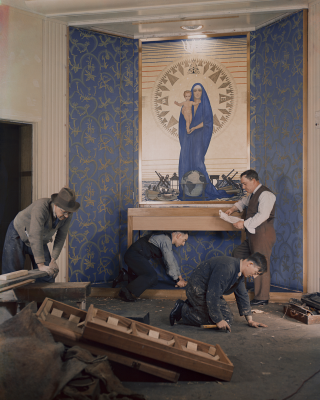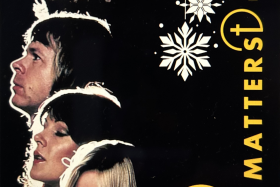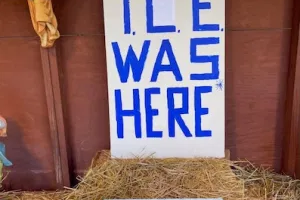Re-opening of National Portrait Gallery

Kenneth Shoesmith's Madonna of the Atlantic, on Queen Mary. Photo by Yevonde. 1936.
Following three years refurbishment at a cost of £41 million, the National Portrait Gallery has re-opened with an imposing entrance in Ross Place, opposite Henry Irving's' statue near the Garrick Theatre. New doors are engraved with 45 bronze relief representations of women through the ages by Tracy Emin.
A spacious entrance hall replaces the previous cramped space with eye catching busts of noted figures including Nelson Mandela. II00 portraits are now displayed including significant purchases like Joshua Reynolds striking 'Omai'.
Contemporary galleries effectively display painted portraiture alongside photographic works. There is an impressive mural of 130 women who have made important contributions to Britain. Lady Margaret Beaufort, Tudor matriarch, features here as well as Elizabeth I alongside figures of various cultural and scientific significance. Where is Elizabeth II? Elsewhere the anodyne Annigoni portrait is on display and a rather small Platinum Jubilee photograph of her and Prince Philip.
Confirming the NPG's new emphasis on photographic portraiture, the stunning opening exhibition is 'Yevonde: Life and Colour' until 15th. October. Born in 1893 and educated at English, Belgian and French boarding schools, Yevonde Middleton was a colourful character. Her dictum was "Be Original or Die." She achieved celebrity as a pioneer of colour photography. Influenced by the Surrealists, she used dramatic props for her vibrant portraits. Society ladies, prominent actors including John Gielgud and Vivien Leigh, and royalty such as Princess Alexandra were amongst those photographed in striking poses. A rare colour picture of George Bernard Shaw is particularly captivating.
In 1936 Fortune magazine commissioned Yevonde to photograph the fitting out of the new luxury liner, the Queen Mary as it neared completion. A recently discovered photograph depicts workmen completing the flooring of the Roman Catholic chapel beneath the altar. A painting, Madonna of the Atlantic, by marine artist Kenneth Shoesmith depicts Mary holding the infant Jesus, standing on the ocean, surrounded by nautical instruments at her feet. Behind her head is a mariner's compass creating a halo effect.
Situated in the First Class drawing room on the Promenade Deck, it was concealed behind folding screens featuring Mediterranean harbour scenes, also by Shoesmith, when the room was not used as a chapel. At the forward end of the room was the altar, with adjoining sacristy.
In 1964, Yevonde went to Addis Ababa and photographed Haile Selassie, Emperor of Ethiopia-capturing him in a black and white portrait with a rare smile and clutching his chihuahua dog.
On the third floor, the last Catholic monarchs can be seen. The Tudor gallery actually begins with the Plantagenet kings of the Wars of the Roses. The first full length portrait of a woman takes centre stage here: Lady Margaret Beaufort, by Netherlandish artist Meynnart Wewyck, painted around 1510, soon after her death, indicating her title as Mother of the King, Henry VII. Above her head is a Tudor Rose on a gold canopy. She is depicted dressed as a vowess in black robe white veil and wimple and kneeling at a Prie - Dieu with her Book of Hours open. Marrying three times she was an important figure as daughter of the Duke of Somerset , descended from Edward III. Her first marriage to Owen Tudor at the age of twelve produced Henry Tudor and she ensured he became king and overthrew the last Plantagenet Richard III.
She took vows of chastity in 1499 whilst married to her third husband, Henry Stanley, a key figure at the battle of Bosworth. Bishop John Fisher, martyred under Henry VIII, became her confessor and under his influence she founded two Colleges at the University of Cambridge. She was a great scholar herself.
The vast Thomas More family portrait by Rowland Lockyer is a copy of the Holbein destroyed by fire and adds More's grandson to the family scene.
A fascinating portrait of William Shakespeare with an earring, probably the only one painted in his lifetime, was the first portrait purchased by the Gallery when it opened in 1856. His eyes seem to follow you around the refurbished room.
There is a new focus on women artists and scientists in history. A fascinating collection of miniatures includes the remarkable Sarah Biffen who had no arms or legs and taught herself to write and paint by mouth as in this self portrait. She painted royalty including George IV and Mrs.Fitzherbert.
Lithographs depict astronomer Caroline Herschel, the first woman to be paid a state salary for her work and receive a pension from George III, and Mary Somerville the first woman to be described in print as a scientist in 1834. A striking full length portrait by artist Margaret Sarah Carpenter, of Ada Lovelace, in 1836 is mesmerising. Daughter of Lord Byron, Ada was a brilliant mathematician and developed the forerunner of computers
On the second floor The Hall of Fame portraits by George Frederic Watts includes Cardinal Manning. The prelate disliked the painting intensely complaining it made him -a teetotaller -look drunk.
Exiting, a plaque reads 'A gallery of the people for the people…a place for everyone'. The refurbishment and rehang is a triumph necessitating several visits .
Main Gallery- Entrance free.
Exhibition charges apply. Special summer £5 for under 30's
For more information see: www.npg.org.uk


















